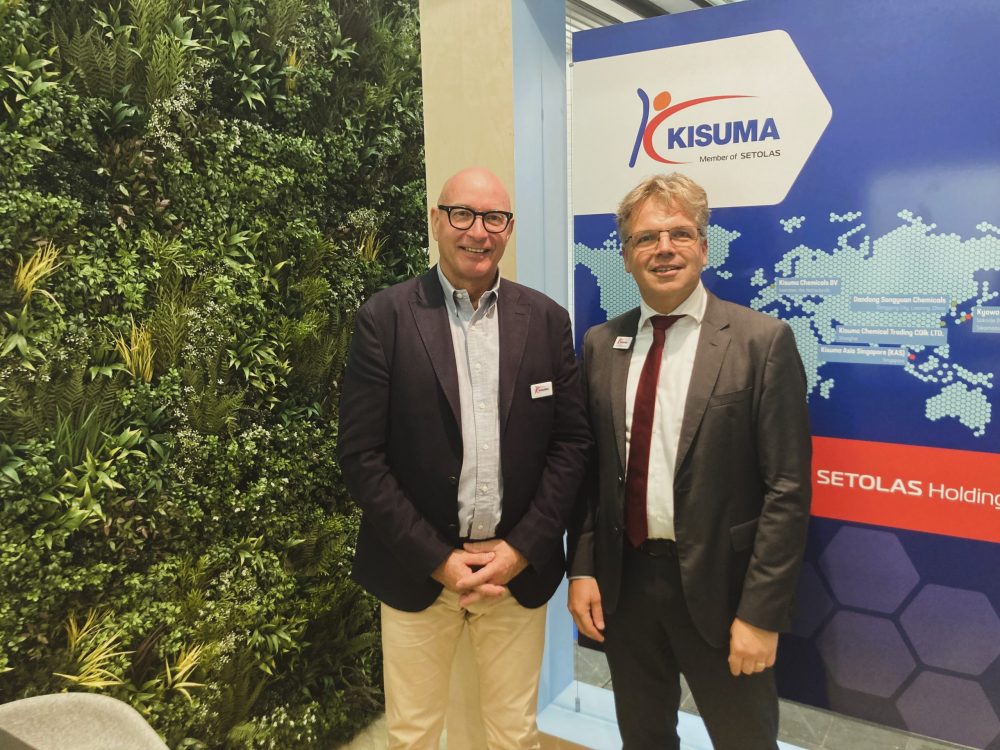Smart Chemistry to Lower Emissions
"We see a bright future in developing solutions that enable sustainable outcomes and help solve global challenges. Therefore, in 2010, Kisuma partnered with TNO's proprietary technology platform, which focuses on the steel, refinery and energy industries, to develop Sorption Enhanced Water Gas Shift (SEWGS) technology - a solution designed for the reactive separation of H2 and CO2 from waste gases with a composition similar to synthesis gas, also known as syngas," explains Managing Director Marcel Oolbekkink.
Kisuma plays an integral role in the development of this technology. STEPWISE is a European Union funded pilot project to reduce carbon footprint in key industrial markets through advanced SEWGS pre-combustion CO2 removal technology. “We are responsible for the development and manufacture of the HiMago sorbent used in SEWGS."
 Tim Hauck (left) and Marcel Oolbekkink are proud of Kisuma's technical achievements that are intended to help reduce emissions. Photo: Circular Technology
Tim Hauck (left) and Marcel Oolbekkink are proud of Kisuma's technical achievements that are intended to help reduce emissions. Photo: Circular Technology
Hydrogen from CO2
According to Kisuma, SEWGS will enable industry to eliminate hard-to-remove CO2 emissions and produce blue hydrogen at a lower cost than previously. To date, we have demonstrated a 30% cost savings over the next best carbon capture alternative, the highest carbon capture purity (97.5%) and blue hydrogen production at 400°C.
Proven in practice
SEWGS is already being successfully demonstrated on an industrial scale – Technology Readiness Level (TRL) 6 – at the Swedish steel company SSAB. The pilot project consists of a 10 meter high, 40 centimeter diameter SEWGS rig containing 3 tonnes of the Kisuma sorbent. The cyclic capacity of this plant is 14 tons of CO2 per day. In 2024, the plant is expected to be expanded to multiple columns that will capture five times more CO2 than the initial STEPWISE pilot, combining continuous production of N2+H2 and CO2 streams with integrated ammonia production. This development is an important milestone in securing the technology required to bring SEWGS to TRL 7 level.
Tim Hauck, Sales & Marketing General Manager at Kisuma explains: “In our view, SEWGS is applicable in all industries where syngas is produced, for example, the steel industry, power industry, refineries, petrochemical and waste gasification, to name just a few. After the pilot project has successfully started, we look forward to making further progress.” For example, Kisuma plans to demonstrate SEWGS in the steel industry at TRL 8 (Technology Readiness Level) by 2026-2027. The technology is expected to be ready for full commercialization in 2028.
"Subject to further proof of practicality at level 8 in 2026 and 2027, we expect to be able to fully commercialize the technology by 2028," adds Tim Hauck. "We are still open to cooperation with new partners in this project and look forward to corresponding discussions and inquiries following K 2022."
Energy efficiency
In the meantime, the company continues to make its production processes more energy efficient. Since going into full operation in 1999, Kisuma claims to have reduced CO2 emissions per tonne of product by 55% - and doubled its plant capacity in the same period.
Continuous innovation
In addition, Kisuma has laid the foundations for future innovations. The recent investment in a state-of-the-art new R&D laboratory is intended to support the diversification of the product portfolio according to market insights. In June 2022, the Company opened a new piloting facility aimed at bridging the gap between small-scale lab testing and bringing new products to market. The facility is designed to process small and medium-sized batches to validate and optimize product quality at scaled production volumes.
Read the original article on Circular Technology's website.
(Original article published in German)



